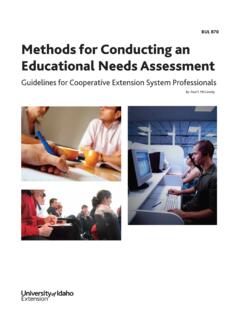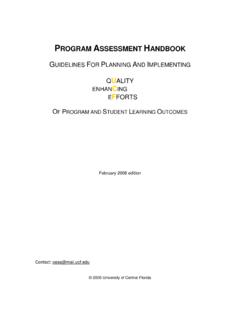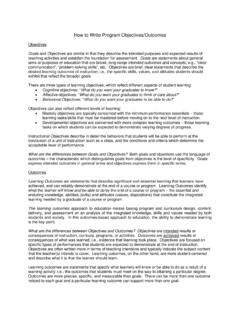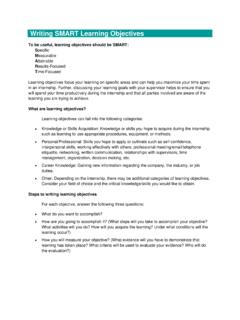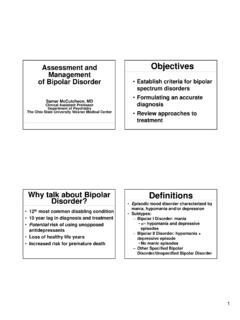Transcription of Introduction to Counseling Assessment LEARNING …
1 3 CHAPTER 1 Introduction to Counseling AssessmentLEARNING OBJECTIVESA fter reading this chapter, you will be able to Describe the relationship between Counseling and Assessment Identify the various types of assessments commonly used in Counseling practice Articulate the history and origins of testing and Assessment practices Recognize the challenges inherent in the practice of Counseling Assessment Identify and locate Assessment competencies required by professional counselors Demonstrate knowledge of Assessment in CACREP accreditation standards Discuss controversial issues in Counseling assessmentAs you continue your training as a professional counselor.
2 You are no doubt beginning to realize that there is no one-size-fits-all Counseling approach that can be applied to all clients. If there were, counselor training programs would require far less coursework to complete. The reason we as counselors have such a variety of approaches, techniques, and interventions at our disposal is that each client who seeks Counseling is unique. Every individual presents with his or her own set of issues and circumstances that allow him or her to experience life differently. What may be viewed as a source of great distress for one person may not even register as a concern for another.
3 Because each client s situation is different, it is important for counselors to acquire as much information about their clients as possible so that they can provide them with treatment options tailored to their specific needs. Copyright 2015 by SAGE Publications, Inc. This work may not be reproduced or distributed in any form or by any means without express written permission of the publisher. Do not copy, post, or distributeSECTION I PRINCIPLES AND FOUNDATIONS OF Counseling ASSESSMENT4 Assessment is the process by which counselors gather the information they need to form a holistic view of their clients and the problems with which they present.
4 As a counselor, you will regularly assess your clients throughout the Counseling process, especially in the early stages. Consider for a moment the following scenario: A female client presents for Counseling tearful and distraught. She states that her life feels like it is falling apart, and she does not know what to do or where to turn for help. As a coun-selor, you probably have many questions you would need answered before you could begin to help this woman. For example, why is she so despondent? What has happened to make her feel like her life is falling apart? How long has she felt this way?
5 Does she have any resources or support to help her through this trying time? Your ability to find answers to these questions will determine how the Counseling process unfolds and how successful it ultimately will be. With so many questions needing answers, it becomes important to know how to effectively employ appropriate Assessment techniques and procedures. In this chapter we will introduce you to the practice of Counseling assess-ment and present an overview of the Assessment process. In addition, we will examine the historical role Assessment has played in both clinical and nonclinical settings.
6 Learn-ing about the important developments and advances that have helped shape Assessment practices and procedures throughout history will help you appreciate how we have reached our current understanding of client IS Assessment ?Before beginning our discussion of Assessment , we believe it would be most beneficial to present an operational definition of the term. In 1985, members from the American Educational Research Association (AERA), the American Psychological Association (APA), and the National Council on Measurement in Education (NCME) got together to produce a document known as the Standards for Educational and Psychological Testing (herein referred to as the Standards).
7 The Standards, written for both a professional and layperson audience, is a collection of best practices that describe how tests should be developed as well as appropriate uses of tests in various educational, psychological, and employment settings. The intent of this group of professionals was to create a frame of reference to which clinicians and test administrators could turn to ensure that they were making and using tests appropriately. The Standards have been revised twice since their original publication date. In the third and most current edition, the term Assessment is defined as a process that integrates test information with information from other sources ( , information from other tests, the individual s social, educational, employ-ment, health, or psychological history) (AERA, APA, & NCME, 1999, p.)
8 3). As you can see, this definition highlights the broad nature of the Assessment process. By collecting client data from various sources, using a combination of formal and informal tech-niques, counselors are able to formulate a more comprehensive and accurate under-standing of the client and his or her reason for presenting for Counseling services (Drummond & Jones, 2010). How does this definition compare to how you previously thought of Counseling Assessment ? Guided Practice Exercise invites you to think about how you conceptualize the Assessment process.
9 Copyright 2015 by SAGE Publications, Inc. This work may not be reproduced or distributed in any form or by any means without express written permission of the publisher. Do not copy, post, or distributeChAPTER 1 Introduction to Counseling Assessment 5 Throughout the professional literature you will see the term Assessment used inter-changeably with other terms such as appraisal and evaluation. Although these may seem like they are the same, there are subtle nuances that differentiate the activities. Like assess-ment, both appraisal and evaluation also make use of various methods of formal and informal data collection.
10 However, a noted difference is in how the collected information is used. When counselors assess clients, their goal is to document and describe what is going on with the clients. Thus Assessment is largely an objective activity. On the other hand, appraisal and evaluation both involve a process whereby counselors are asked to make judgments based on the evidence that they collect. These activities are more subjec-tive in nature. Considering the reasons you need to acquire information about your client s presenting problem will help you understand which activity you actually are term you might see used in the literature is psychological testing.












